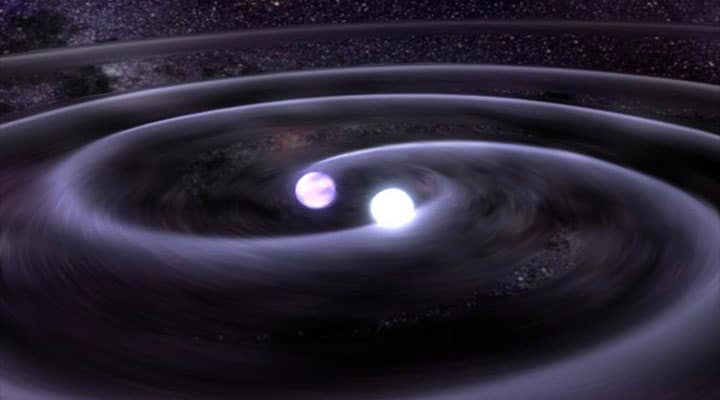

The team responsible for confirmation of gravity wave signals were kind enough to take questions on Reddit yesterday. This is an edited round-up of the best.

1. How would you explain to someone who has no idea what any of this means the importance of your discovery?
When Galileo used a telescope to look at the sky for the first time, he opened up a new window on the universe. Soon, telescopes were able to see stars and galaxies from far away, and we learned more and more about the universe around us.
LIGO is a new way to understand the universe, one that doesn’t use light like a traditional telescope but gravitational waves. Our data is in the audio frequency range, so the analogy we use is that finally we can “listen” to the universe. This means we can start understanding things that we thought would exist and haven’t seen before (such as black holes colliding), and hopefully things we didn’t even imagine would exist!
2. When did the project that led to detection of the waves begin?
“Initial” LIGO ran for eight years, from 2002 to 2010, as a proof of concept for the detector setup. Then we upgraded it and turned it back on in Fall 2015! Our first observing run ran from September through January of this year. But the LIGO itself project started much earlier, in the 1990s. And efforts to detect GWs have been on people’s minds since the 1960s! (And of course it all leads back to Einstein 100 years ago).
3. How many people were involved in discovery in total?
There are around 1000 people currently in the collaboration, and hundreds more that have been involved since its inception almost 30 years ago.
4. How do gravitational waves interact with matter?
They don’t, really – not in the way you would expect light or radio waves to interact with matter. They pass through everything, stretching the space they are in slightly in the process.
5. Do gravitational waves generate energy and can we harness it?
The reason it is so hard to measure gravitational waves is the same reason it’d be hard to extract a useful amount of energy from it. Gravitational waves just interact so weakly with matter that even though they carry a lot of energy, the energy just goes right through everything
6. How quickly do gravity waves decay? Are they a viable option for extreme long-range communication?
The speed of gravity waves are equal to the speed of light in a vacuum. Since this particular wave travelled 1.3 billion light years we know they don’t decay quickly, but neither are they a better form of long range communication than light.
7. Does the confirmation of these really hard-to-detect gravitational waves mean any re-calculations of existing physics has had to be done?
Not yet! Everything about this first detection falls in line with our expectations from what we know about physics. The rate at which binary black holes form in nature and the masses of the binary black holes are consistent with theoretical predictions (mostly because those predictions were very broad). And the signal itself matches what we expect from general relativity to as-well-as-we-can-measure for this event. We will be watching future events very careful for any departures from theory. That is when the real fun begins.
8. If a gravitational wave was powerful enough, would a human be able to feel/experience it going through them?
We did some calculations which suggest that if you were in a space-ship close to the merging black holes you would feel a force which was pretty comparable to the force you feel by standing next to a loudspeaker at a music concert. You’d feel a vibration travelling through your body, but we were pretty confident it wouldn’t hurt you!
9. When a gravity wave passes through you, or through LIGO, the Earth, etc, does our relative time slow down by a tiny amount, too?
Let’s say the wave slows time by one second. The wave originates from the merger of the two black holes. As the wave moves outward, it slows time by one second, in an expanding ring which passes through you at a fixed point in time and space. Your relative time is slowed by one second, as was time in the space between you and the merger.
But the ring doesn’t stop when it passes through you, of course, it keeps going. So it slows time through all of space beyond you as well. And it slows at a consistent one second. You would be one second in time behind the space at your back, but only for the amount of time it takes the ring to move through you.
Eventually (if the ring continues expanding to the far reaches of the universe) all time would ‘normalize’ and be one second behind where it would have had been.
10. How is it even conceivable to measure such a small distance?
An interferometer measures the length change relative to the wavelength of the light – so already we’re at 10-7 m. Now we’re looking at detecting the fringe shift at the output of the interferometer, which we can detect to a sensitivity of 10-9 at a power of 1mW (we’re operating at a dark port configuration, which means hardly any power leaves the interferometer – there is a build up of a few hundred kW in the arms!). By sending the signal back into the interferometer to let it build up as well, we can increase that sensitivity to 10-13, which already enables us to detect a length change of 10-20 m. However, the arms are several kilometres long, and we’re detecting the length change relative to the entire arm – this puts us at our design sensitivity of up to 10-23.
11. Now that we have confirmed Einstein’s long-time hypothesis, are there any direct applications of this discovery?
Not directly, no. But that isn’t always the point of this kind of research. In order to make this discovery, a whole bunch of technology has been developed for this! Really precise optics that were used here have a whole bunch of industrial plants. The sensing equipment that’s placed all around the detectors have given a really great insight into how really unrelated phenomena can be linked. Some of the codes developed could be used in a really wide range of other places, now that big data management has become key in so many industries.
12. What do you see as the scientific possibilities for observations of gravitational waves using this approach?
As you say, it’s going be a whole new branch of astronomy, so there are MANY possibilities. Right now we are mostly hoping for more binary systems – either more binary black holes, or maybe double neutron stars, or one neutron star plus one black hole. But we are also searching for single rapidly spinning neutron stars that would give us a wholly different signal – continuous over the whole observation span, but even weaker. And for signals from supernovae: exploding massive stars. Or maybe even the very elusive signals from the early universe – right after the big bang – if we get really lucky.
And of course, any new observation will not only tell us something about that individual astronomical source – but also further allow us to test Einstein’s generally relativity to ever higher precision and under new circumstances.
13. How are gravitational waves affected by inflation?
The GWs from Inflation [for most of the Inflationary models!] are at very low frequencies. So, if you are talking about interference of those with GWs from compact objects (such as BHs, NSs) – which is possible, we may see some modulation [from interference] in frequency as well as amplitude domain. However, the predicted GWs from Inflation are at very, very low amplitudes as well (besides the low frequency!), roughly in the 1.0e-30 – 1.0e-27 range. This makes them really hard to separate by de-modulation, in frequency as well as amplitude.
If you are wondering about emission of GWs from Inflation, we are not currently able to detect those because of their extremely small amplitudes. Also, at low frequencies of primordial GWs (from Inflation), Seismic noise in ground-based detectors is overwhelming. We will have to wait for eLISA to sort out the primordial GWs. However, it is possible to see their effect on CMB (Cosmic Microwave Background) photons’ polarisations, which is what BICEP2 was trying to accomplish.
One could argue if there are Inflationary models which predict louder Primordial GWs. A: We haven’t see any such stochastic background, if it is loud enough. B: Models predicting loud GW emissions are currently ruled out by Planck mission results [CMB].
14. What are some misconceptions that have been proliferating in the wake of your announcement that you’d like to dispel?
That these are not gravity waves! A gravity wave is a wave through fluids, such as an atmosphere, or an accretion disk around a large object. This is a very different phenomenon from gravitational waves!
15. What role does the Higgs Mechanism play, if any, in gravitational waves?
The Higgs mechanism is very quantum mechanical, whereas GW’s are (so far) a purely classical, non-QM phenomenon. However, as a form of energy, the Higgs (and all other particles, mass, energy) contributes to gravity. But… quantum gravity is poorly understood and at the forefront of current research, so we don’t really know exactly how the Higgs contributes to gravity, only that it does. It’s essentially irrelevant for our LIGO discovery.
16. Can observing gravitational waves help understand the role of Dark Matter and Dark Energy in the universe?
Our understanding of Dark Matter and Dark Energy come in part from our understanding of gravity. Gravitational waves are a consequence of gravity that we now, for the first time, are able to measure. As we continue to observe gravitational waves we will continue to learn more about gravity and it is possible, though no guarantee, that they will guide our understanding of the “dark side” of the Universe.
Dark matter and dark energy have had a big role in the history of the universe expanding (in fact we think dark energy is now causing that expansion to speed up!) and in the formation of galaxies and clusters of galaxies. But we don’t expect dark matter to exist in nearly dense enough ‘clumps’ to produce gravitational waves that could be detected by LIGO.
In the future, however, astronomers hope to use gravitational wave sources such as compact binary coalescence to map out the cosmos, completely independently of the methods available right now — using e.g. the CMBR or distant supernovae. So it’s possible that future gravitational wave observations could help us to better understand the effects of dark matter and dark energy on the expansion of the universe.
17. How do you guys think this will change the way we understand the universe?
The direct detection of gravitational waves really marks the beginning of an entirely new era of observational astronomy. Up until now it’s like we’ve been watching a movie with the sound turned off. You get a lot of information just from seeing, but it’s only half the story. With LIGO we’ve finally cranked up the stereo!
We hope to learn a great many things about compact objects like black holes and neutron stars: from the astrophysics that governs how they form and evolve, to how they interact with each other and the surrounding universe. And as other observatories (like LISA and pulsar timing arrays) develop, we’ll start to will answer questions about supermassive black holes in the centre of galaxies, the way dark matter is distributed in the universe, and maybe even start us on the way to understanding dark energy!
But I think the most exciting thing is all the stuff we don’t expect! Even this discovery surprised us in a way by showing not only can you get 30+ solar mass black holes naturally, but they can evolve and merge within the age of the universe. And that’s only the beginning! Gravitational waves are going to answer questions we haven’t even thought to ask yet.
18. How often should we expect to see gravitational events of this magnitude and what’s the ‘next step’ in gravitational astronomy?
How often we see events depends on the sensitivity of the instrument. We found this 1 event to be the loudest signal in about 39 days of calendar data. So, a rough estimate is that if we keep the detectors the same, we could see about one event this loud per month. In practice, we hope to increase the sensitivity of the detectors, and find an even higher rate. JBK, at Caltech
19. How can you be sure that the energy radiated away in the black hole merger was lost predominately due to gravitational waves and not due to some other mechanism (e.g. EM radiation)?
We can’t be sure that nothing else was emitted. The waveform is in great agreement with General Relativity (GR), which, if correct, predicts this energy loss (and is consistent with the energy we detect in GWs). If it ALL went out in light, the sky (for that fraction of a second) would be brighter than the full moon! We had telescopes pointing in the direction of the event (minutes, hours later), we await word from our partners whether they saw anything. Maybe the Fermi gamma ray telescope saw something; they’re not sure.
20. Why are black holes considered to be holes?
Black holes have such a strong gravitational pull that not even light can escape them. Anything that falls into one will never be seen again – similar to when stuff falls into a hole. Really, black holes consist of a singularity in the centrum of the event horizon. In any drawing that visualises space-time as a rubber sheet, they will actually look like a hole as well though – that probably contributed to that perception. It’s just a really catchy name!
21. Do the scientists have weekends, or do they work every day? How long do they usually work a day?
Different scientists work different schedules! (I myself, take weekends unless there’s a deadline coming up!) But most of us are always thinking about science at least a little!








